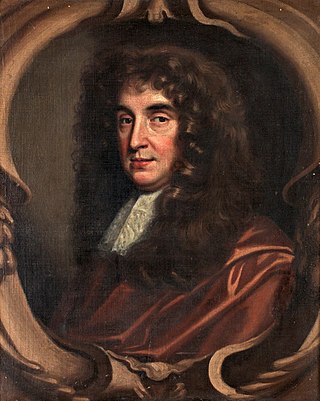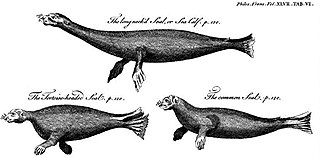Daniel Colwall (died 1690) was a British merchant and philanthropist.
Contents

Daniel Colwall (died 1690) was a British merchant and philanthropist.

Colwall became one of the original Fellows of the Royal Society on 20 May 1663 and was elected to its council in the following November. He served as the Society's treasurer for from 1665 to 1679. In 1663 and 1666, he presented the society with £50, while continuing his weekly payments. He died in the Liberty of the Tower of London in November 1690.
With Colwall's money, the collection of "rarities formerly belonging to Mr. Hubbard" [1] was acquired in 1666, and kept in Gresham College, a first step towards the formation of a museum. The preparation of the catalogue was entrusted to Dr. Nehemiah Grew, who published it in 1681 with the title Musæum Regalis Societatis. [2] This book is embellished with 31 plates, many of which, if not all, were engraved at Colwall's expense.
He had long been a governor of Christ's Hospital, to which in his lifetime he was a liberal benefactor. In his will, dated 12 August, with codicil dated 19 August, proved on 20 November 1690, he bequeathed to the school 'for ever one rent or yearly payment of sixty-two pounds and eight shillings issuing and payable out of the hereditary excise which was assigned to me by Sir Robert Viner, knt. and bart., deceased,' and the sum of £4,000.
James Granger, [3] followed by Owen Manning and William Bray, [4] and Edward Wedlake Brayley and John Britton [5] confused Colwall with his great-nephew of the same name, of the Friary, near Guildford, and the son of Arnold Colwall.

John Flamsteed was an English astronomer and the first Astronomer Royal. His main achievements were the preparation of a 3,000-star catalogue, Catalogus Britannicus, and a star atlas called Atlas Coelestis, both published posthumously. He also made the first recorded observations of Uranus, although he mistakenly catalogued it as a star, and he laid the foundation stone for the Royal Greenwich Observatory.

Sir Christopher WrenFRS was an English architect, astronomer, mathematician and physicist who was one of the most highly acclaimed architects in the history of England. Known for his work in the English Baroque style, he was accorded responsibility for rebuilding 52 churches in the City of London after the Great Fire in 1666, including what is regarded as his masterpiece, St Paul's Cathedral, on Ludgate Hill, completed in 1710.

John Eliot was a Puritan missionary to the American Indians who some called "the apostle to the Indians" and the founder of Roxbury Latin School in the Massachusetts Bay Colony in 1645. In 1660 he completed the enormous task of translating the Eliot Indian Bible into the Massachusett Indian language, producing more than two thousand completed copies.

Charles Paulet, 1st Duke of Bolton, was an English nobleman, the son of John Paulet, 5th Marquess of Winchester, and his first wife, Jane Savage.

Philip Fruytiers (1610–1666) was a Flemish Baroque painter and engraver. Until the 1960s, he was especially known for his miniature portraits in watercolor and gouache. Since then, several large canvases signed with the monogram PHF have been ascribed to him. These new findings have led to a renewed appreciation for his contribution to the Antwerp Baroque.

Colonel Robert Carter I was a planter, merchant, and government official and administrator who served as Acting Governor of Virginia, Speaker of the Virginia House of Burgesses, and President of the Virginia Governor’s Council. An agent for the Northern Neck Proprietary, Carter emerged as the wealthiest Virginia colonist and received the sobriquet “King” from his contemporaries connoting his autocratic approach and political influence. Involved in the founding of the College of William and Mary, he acquired at least 300,000 acres and engaged one thousand enslaved laborers on fifty plantations. Carter was the largest land owner in Virginia.
Robert Bertie, 3rd Earl of Lindsey PC FRS, styled Lord Willoughby de Eresby from 1642 to 1666, was an English nobleman.
Events from the year 1656 in England.

Robert Paston, 1st Earl of Yarmouth, FRS was an English scientist and politician who sat in the House of Commons between 1660 and 1673 when he was created Viscount Yarmouth. He was created Earl of Yarmouth in 1679.
Sir Richard Onslow was an English politician who sat in the House of Commons at various times between 1628 and 1664. He fought on the Parliamentary side during the English Civil War. He was the grandson of one Speaker of the House of Commons and the grandfather of another, both also called Richard Onslow.

Daniel O'Brien, 3rd Viscount Clare, was with King Charles II in exile during the interregnum. At the Restoration, he obtained the title of Viscount Clare for his grandfather and full restoration of the family's lands. At the Glorious Revolution he supported James II, sitting in the Patriot Parliament and fighting for him at the Battle of the Boyne. He was in consequence attainted as a Jacobite.
Philip Packer FRS was an English barrister and architect. He was a courtier to Charles II, and friend to Christopher Wren.
Sir Samuel Tuke, 1st Baronet was an English officer in the Royalist army during the English Civil War and a notable playwright. He is best known for his 1663 play The Adventures of Five Hours, possibly co-authored by George Digby – the play was produced by the Duke's Company and later proved an influence on Richard Brinsley Sheridan's opera The Duenna.
Arthur Moore M.P., of Fetcham Park, Surrey, was an Irish businessman, economist and Tory politician who sat in the English and British House of Commons between 1695 and 1722.

Robert Phelips was a Royalist officer during the English Civil War. After the Restoration he was a Member of Parliament, and from 25 May 1687 until 21 March 1689 Chancellor of the Duchy of Lancaster.
Sir Philip Skippon, FRS, of Foulsham, Norfolk, Wrentham and Edwardstone, Suffolk, was an English traveller, writer, diarist, landowner and MP.
John Machell (1637–1704) was for twenty years Member of Parliament for Horsham, Sussex, during the reigns of Charles II, James II and William III and Mary II. By the marriage of his daughter Isabella Machell (1670–1764) to Arthur Ingram, 3rd Viscount of Irvine, he became the grandfather of the fourth, fifth, sixth, seventh and eighth Viscounts of Irvine, and great-grandfather of the ninth, seated at Temple Newsam near Leeds, whose family inherited and augmented his valuable property of Hills house at Horsham, and continued the parliamentary tradition there.

Arnold van Westerhout or Arnoldo van Westerhout was a Flemish printmaker, painter, draughtsman, publisher and printer. He trained in Antwerp but mainly worked abroad, and in particular in Italy. He settled in Rome where he was a prominent printmaker and publisher. The artist is less known for his paintings, which covered religious and genre subjects, than for his work as a printmaker and publisher.

The long-necked seal is a hypothetical species of earless seals. It was first described in 1681 by Nehemiah Grew, based on a skin of unknown provenance in the museum of the Royal Society. An illustration of this specimen was published by James Parsons in 1751. In 1792, Robert Kerr gave it the scientific name Phoca mutica. In 1800, George Shaw proposed the alternate scientific name Phoca longicollis. The skin has not been relocated since then, so the existence of the species remains unconfirmed.
![]() This article incorporates text from a publication now in the public domain : "Colwall, Daniel". Dictionary of National Biography . London: Smith, Elder & Co. 1885–1900.
This article incorporates text from a publication now in the public domain : "Colwall, Daniel". Dictionary of National Biography . London: Smith, Elder & Co. 1885–1900.
This article relies largely or entirely on a single source .(January 2011) |